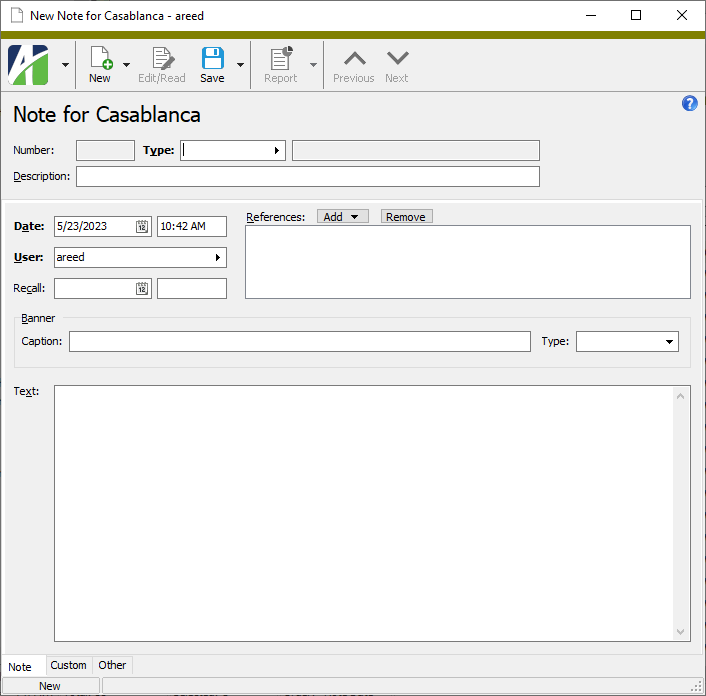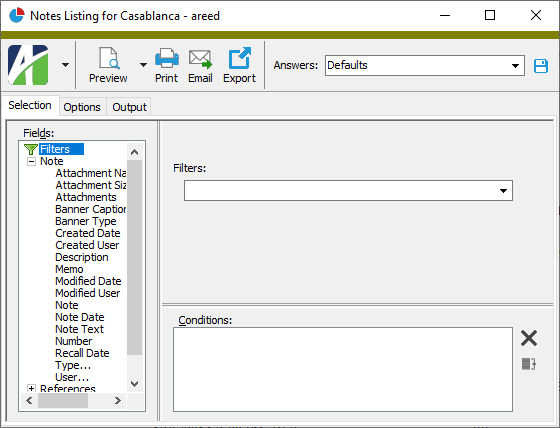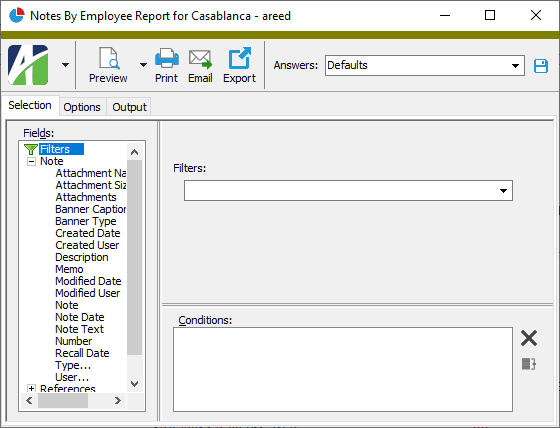Payroll notes contain comments about employees, positions, and other entities in Payroll and Human Resources. Notes are grouped by note type.
Create a payroll note
You can create payroll notes from the Notes folder or from the Notes tab of employees, contacts, payroll records, checks, attributes, note types, positions, and segment items.
Create a payroll note
- In the Navigation pane, highlight the Payroll/Human Resources > Notes folder.
- Click
 . The New Notes window opens.
. The New Notes window opens.
- In the Type field, select the note type.
- Enter a Description of the note.
- In the Date fields, enter the date and time of the note. The default date and time are the current date and time.
- In the User field, select the name of the user to associate with the note. The default user is the current user, but any authorized user name can be entered.
- In the Recall fields, enter the date and time to follow up on this note.
- If you want to include references to other records in the note, add them in the References list box. To do so:
- Click Add and select the type of record to reference from the drop-down menu. The Find dialog box opens with a list of records you can reference.
- Select the record to reference and click OK. The reference is added to the list box.
- To display a banner on all employee records referenced on the note, respond to the fields in the Banner section. Otherwise, skip to step 10.
Notes
- Because banners are note specific, multiple banners can appear on a given employee record.
- When a note banner is displayed on a record, you can click the banner caption to open the associated note record.
- In the Caption field, enter the message to display in the banner. Captions can contain up to 255 characters.
- From the Type dropdown, select the banner type. The banner type determines which icon displays to the left of the caption. The default banner type is "Information". Valid types are:
 Error
Error Help
Help Information
Information Warning
Warning
- In the Text field, enter the text of the note.
- Save the new payroll note.
Notes Listing
Purpose
Content
For each note included on the report, the listing shows:
- note number
- note date and time
- note type
- note type description
- recall date and time
- user who entered the note
- reference(s) to other record(s)
- note description
- note text.
In addition, you can include one or more of the following:
- timestamps
- custom fields.
The following total appears on the report:
- record count.
Print the report
- In the Navigation pane, highlight the Payroll/Human Resources > Notes folder.
- Start the report set-up wizard.
- To report on all or a filtered subset of payroll notes:
- Right-click the Notes folder and select Select and Report > Notes Listing from the shortcut menu.
- On the Selection tab, define any filters to apply to the data.

- To report on specifically selected notes:
- In the HD view, select the notes to include on the report. You can use Ctrl and/or Shift selection to select multiple records.
- Click
 and select Notes Listing from the drop-down menu.
and select Notes Listing from the drop-down menu.
- To report on a particular payroll note from the Note window:
- In the HD view, locate and double-click the note to report on. The Note window opens with the note loaded.
- Click
 and select Notes Listing from the drop-down menu.
and select Notes Listing from the drop-down menu.
- To report on all or a filtered subset of payroll notes:
- Select the Options tab.

- Mark the checkbox(es) for the additional information to include:
- Timestamps
- Custom Fields (only visible if custom fields are set up)
- Select the Output tab.
- In the Design field, look up and select the report design to use.
- In the toolbar, click the icon for the type of output you want:
 - Provides access to two preview options.
- Provides access to two preview options.- Preview - Click the icon or click the drop-down arrow and select Preview from the drop-down menu to view the report in the Crystal Reports viewer.
- Preview to PDF - Click the drop-down arrow next to the icon and select Preview to PDF to view the report in the PDF reader.
 - Opens the Print dialog so that you can select and configure a printer and then print a paper copy of the report.
- Opens the Print dialog so that you can select and configure a printer and then print a paper copy of the report. - Opens the Report Email dialog so that you can address and compose an email that the report will be attached to. For best results, ensure your email client is running before you attempt to send a report via email.
- Opens the Report Email dialog so that you can address and compose an email that the report will be attached to. For best results, ensure your email client is running before you attempt to send a report via email. - Opens the Export Report dialog so that you can save the report to a file. File types include Crystal Reports (.rpt), PDF (.pdf), Microsoft Excel (.xls), Microsoft Word (.doc), rich text (.rtf), and XML (.xml).
- Opens the Export Report dialog so that you can save the report to a file. File types include Crystal Reports (.rpt), PDF (.pdf), Microsoft Excel (.xls), Microsoft Word (.doc), rich text (.rtf), and XML (.xml).
Data extensions
The following data extensions are available for the report:
- Notes
- Note types
Notes by Employee Report
Purpose
The Notes by Employee Report shows the notes associated with each employee that is referenced in the notes. If a note refers to multiple employees, the note is reported for each employee referenced.
Content
For each employee included on the report, the report shows:
- note details.
For each note included on the report, the report shows:
- note number
- note date
- recall date
- note type
- note type description
- user who entered the note
- note description
- note text.
In addition, you can include one or more of the following:
- timestamps
- custom fields.
The following total appears on the report:
- record count.
Print the report
- In the Navigation pane, highlight the Payroll/Human Resources > Notes folder.
- Start the report set-up wizard.
- To report on all or a filtered subset of notes:
- Right-click the Notes folder and select Select and Report > Notes by Employee Report from the shortcut menu.
- On the Selection tab, define any filters to apply to the data.

- To report on specifically selected notes:
- In the HD view, select the notes to include on the report. You can use Ctrl and/or Shift selection to select multiple records.
- Click
 and select Notes by Employee Report from the drop-down menu.
and select Notes by Employee Report from the drop-down menu.
- To report on a particular note from the Note window:
- In the HD view, locate and double-click the note to report on. The Note window opens with the note loaded.
- Click
 and select Notes by Employee Report from the drop-down menu.
and select Notes by Employee Report from the drop-down menu.
- To report on all or a filtered subset of notes:
- Select the Options tab.

- Mark the checkbox(es) for the additional information to include:
- Timestamps
- Custom Fields (only visible if custom fields are set up)
- Select the Output tab.
- In the Design field, look up and select the report design to use.
- In the toolbar, click the icon for the type of output you want:
 - Provides access to two preview options.
- Provides access to two preview options.- Preview - Click the icon or click the drop-down arrow and select Preview from the drop-down menu to view the report in the Crystal Reports viewer.
- Preview to PDF - Click the drop-down arrow next to the icon and select Preview to PDF to view the report in the PDF reader.
 - Opens the Print dialog so that you can select and configure a printer and then print a paper copy of the report.
- Opens the Print dialog so that you can select and configure a printer and then print a paper copy of the report. - Opens the Report Email dialog so that you can address and compose an email that the report will be attached to. For best results, ensure your email client is running before you attempt to send a report via email.
- Opens the Report Email dialog so that you can address and compose an email that the report will be attached to. For best results, ensure your email client is running before you attempt to send a report via email. - Opens the Export Report dialog so that you can save the report to a file. File types include Crystal Reports (.rpt), PDF (.pdf), Microsoft Excel (.xls), Microsoft Word (.doc), rich text (.rtf), and XML (.xml).
- Opens the Export Report dialog so that you can save the report to a file. File types include Crystal Reports (.rpt), PDF (.pdf), Microsoft Excel (.xls), Microsoft Word (.doc), rich text (.rtf), and XML (.xml).
Data extensions
The following data extensions are available for the report:
- Notes
- Note types
- Employees
Note Record ID
The note type.
Press F3 to look up the value.
If a value is already selected, you can press F4 to open the record in its native editor.
Note tab
The name of the user to associate with the note. The default user is the current user, but you can enter any authorized user name.
Press F3 to look up the value.
If a value is already selected, you can press F4 to open the record in its native editor.
Note
- Because banners are note specific, multiple banners can appear on a given employee record.
- When a note banner is displayed on a record, you can click the banner caption to open the associated note record.
 Error
Error Help
Help Information
Information Warning
Warning
Custom tab
This tab is visible if custom fields exist for the entity. At a minimum, if there are custom fields, a Fields subtab will be present. One or more additional categories of subtabs may also be visible.
Fields subtab
This tab prompts for values for any custom fields set up for entity records of this entity type. Respond to the prompts as appropriate.
References subtab
This tab is visible if other records reference the current record.
Example
Suppose a custom field exists on PRCodes that references an ARCode. On the ARCode record, on the Custom > References subtab, you can view all the PRCodes which reference that ARCode.
Exchange Folder subtab
This tab is visible only if you set up a custom field with a data type of "Exchange Folder". The label on this tab is the name assigned to the custom field.
This tab shows the contents of the specified Exchange folder.
File subtab
This tab is visible only if you set up a custom field with a data type of "File". The label on the tab is the name assigned to the custom field.
This tab renders the contents of the specified file according to its file type.
Internet Address subtab
This tab is visible only if you set up a custom field with a data type of "Internet Address". The label on this tab is the name assigned to the custom field.
This tab shows the contents of the specified web page.
Network Folder subtab
This tab is visible only if you set up a custom field with a data type of "Network Folder". The label on this tab is the name assigned to the custom field.
This tab shows the contents of the specified network folder.
Attachments tab
The Attachments tab is visible if any record for a given entity has an attachment. If the Attachments tab is not visible, this implies that no record of the entity type has an attachment on it; however, once an attachment is added to any record of the entity type, the Attachments tab will become available.
Other tab

|
Extras\Payroll\Import Employee Notes.xls |
Payroll notes security
Common accesses available on payroll notes
Payroll notes filters
The following built-in filters are available for payroll notes:
Report Email dialog
- Windows user default account. Sends email using the user's Windows default email account. For most users, this is the account configured in Outlook or another email client application.
- Server personal. Sends email using the email configuration for the system or company server and the email address on the current user's authorized user record. The authorized user record must have a confirmed email address.
- Server generic. Sends email using the email configuration and "from" address for the system or company server. This option requires "Send generic" access to the Server Email resource.
|
5225 S Loop 289, #207 Lubbock, TX 79424 806.687.8500 | 800.354.7152 |
© 2025 AccountingWare, LLC All rights reserved. |